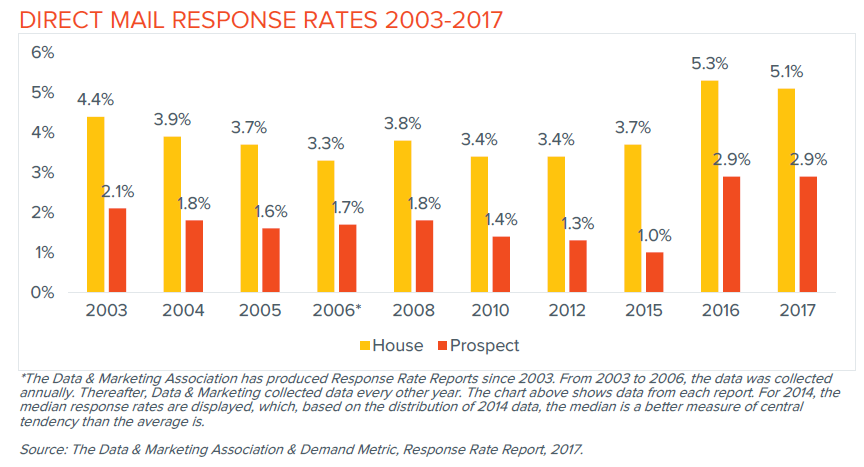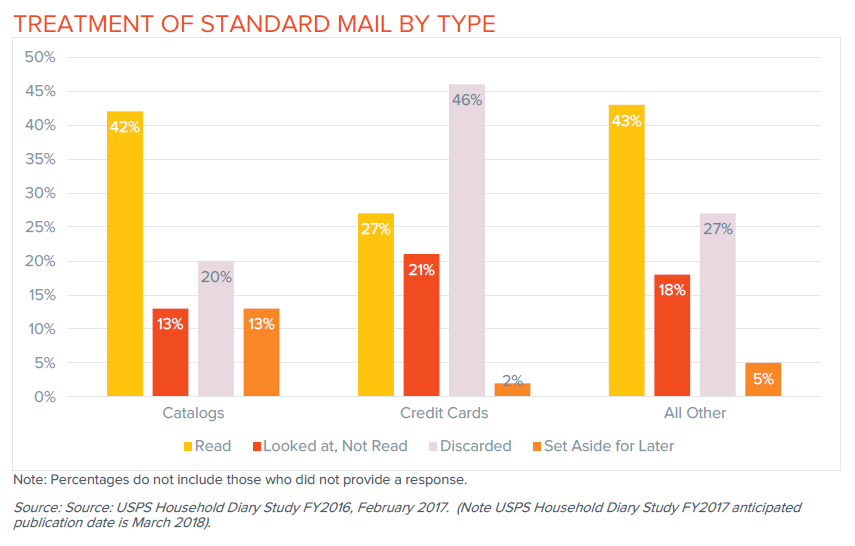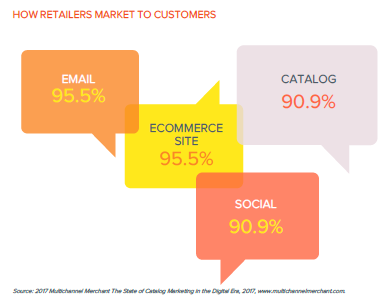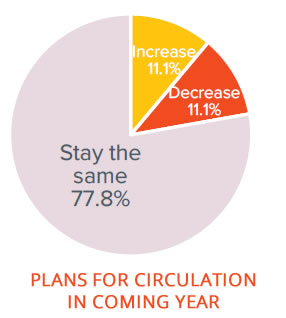
Lois Brayfield, CEO J.Schmid

Debbie Roth, VP Sales & Marketing | Japs Olson
Lois Brayfield, J.Schmid CEO, and Debbie Roth, Japs-Olson Company VP Sales & Marketing, offer their take on the catalog and direct mail industry in the recently published DMA Statistical Fact Book 2018. Learn more about this valuable resource packed with recent research for all marketing tactics here.
According to the stats, recipients of direct mail find it a compelling medium. With new print technologies and the ability to create segmentation strategies around the customer journey using real-time data, the ability to create efficient, results-producing advertising is at every marketer’s fingertips. Let’s take a look at two segments of this power medium.
Direct Mail
For those of you who are already on the direct mail bandwagon – because you really should be in this day and age – here’s what you should know about 2018: It’s going to be irresistibly amazing! Moreover, why shouldn’t it be given all the traditional, innovative and emerging technologies combining to create stunning pieces for a lasting impression? Certainly, the research indicates that direct mail will continue its appeal as long as there is:
Proactive targeting of customers.
- 1:1 personalization.
- A well-written visual piece utilizing the latest printing techniques.
- A strong creative offer that conveys a call-to-action.
- A coordinated strategy of cross channel marketing.

Yes, we all know it’s a digital world out there but guess what –people still like to receive and respond to direct mail. According to statistics in this chapter, response rates for House files jumped 37% and Prospect files almost 3 times from just a few years ago. Even Millennials who have a strong relationship with technology love direct mail.
 As noted in the USPS Mail Moments Review, 84 percent of Millennials take the time to look through their mail and 64 percent would rather scan for useful information in the mail than e-mail. In addition, this generation even believes paper mail is a more reliable and viable source of communication.
As noted in the USPS Mail Moments Review, 84 percent of Millennials take the time to look through their mail and 64 percent would rather scan for useful information in the mail than e-mail. In addition, this generation even believes paper mail is a more reliable and viable source of communication.
At least one neuroscience study (USPS and the Center for Neural Decision Making at Temple University’s Fox School Business) says there is a reason why people respond differently to physical and digital pieces. It’s because physical pieces trigger activity in a part of the brain that corresponds with value and desirability. As a result, people spend more time and have a stronger emotional response to physical pieces and they remember them better.
Not only is direct mail relevant, people trust it because it seems more ‘real,’ it’s tactile, personal and it’s private. So don’t ignore this channel in the media mix and be sure to use technologies that will enhance the consumer interaction. Here are some innovative applications that should be considered for a direct mail piece to stand out from the cluttered communication landscape:
- Texture and scent to enhance interactivity and provide a sensory experience.
- Simulated virtual reality (VR) – anyone interested in a 360 tour?
- Real world sensory augmented reality (AR) to shop and purchase from home.
- QR codes which are increasingly sophisticated for trackability.
- Near field communication (NFC) to enable electronic devices to communicate with each other.
It’s all a road map for integration with other media channels to drive higher consumer response rates. However, like most industries, there are challenges on the road to irresistible mail. The first is data hygiene, because addresses need to be precise and personalization is key for brand credibility. The second is the ongoing need for a viable USPS, which at the start of this year is still awaiting postal reform legislation.
Overall, an exciting year is ahead for direct mail, and a future that will keep changing and providing great opportunities for marketers and brands to make consumer connections. With better targeting to specific consumer interests, the knowledge that people enjoy receiving and responding to appealing mail, along with just-in-time delivery, what’s old is new again.
Catalogs

 This powerful, century-old tactic is still adding revenue to the bottom line, as proven by the numbers and the influx of new brands producing catalogs. According to the data in this chapter, 90.9% of merchants list catalogs as a primary marketing tool, with 44.4% of merchants reporting their circulation increased in the past year. And 42% of catalog recipients reported reading catalogs with another 25% glancing through or saving catalogs for later. Yes, catalogs still work. And many cite it as an integral part of an omnichannel strategy driving purchasing behavior. However, the toolbox we once used to create successful programs doesn’t necessarily have the same set of tools in it today. Consider the following:
This powerful, century-old tactic is still adding revenue to the bottom line, as proven by the numbers and the influx of new brands producing catalogs. According to the data in this chapter, 90.9% of merchants list catalogs as a primary marketing tool, with 44.4% of merchants reporting their circulation increased in the past year. And 42% of catalog recipients reported reading catalogs with another 25% glancing through or saving catalogs for later. Yes, catalogs still work. And many cite it as an integral part of an omnichannel strategy driving purchasing behavior. However, the toolbox we once used to create successful programs doesn’t necessarily have the same set of tools in it today. Consider the following:
1. Brands continue to report the mailing catalogs as a way to drive web traffic, followed closely by customer retention and brand building (MCM OUTLOOK: Catalog).
Unfortunately, it appears many marketers still create a catalog as if it were a channel to purchase products. It’s not. Catalogs drive customers to a point of purchase. Therefore, brands must focus their efforts on highly creative presentations, focusing on customer benefits and strong calls-to-action.
2. Catalogs – and other media – still face the ongoing challenge of attribution. However, data tools have evolved to allow detailed views of the overlap of print and online activities and will serve as a foundation for broad strategic opportunity. This will only allow for smarter, more efficient prospect mailings with potential in increased response rates.
3. In a previously reported study, 41% of millennials and 53% of Gen Xers reported enjoying catalogs (Quad/Graphics Customer Focus® 2016 Research Study). The younger generation appreciates this medium but messaging must support their expectations. Thankfully, new technology can offer insight into the customer journey, allowing for strategic segmentation and targeting. This will create more efficiencies and expanded opportunities in 2018.
4. Amazon continues to be part of a catalog brand’s daily conversation. While some have worked the metrics in their favor, all agree that proprietary merchandise or positioning is more critical than ever before. A unique brand alone will not cut it.
5. The US Postal Service has come to a crossroads in 2018 with both the release of its “Ten-Year Review” and recognized unsustainable financial losses. The Postal Regulatory Commission has options for increases in postage rates on its agenda. The only question left is how much and how fast. Catalog mailers must optimize paper and design options to remain profitable.
6. There is a noticeable increase in a new breed of catalogs. They are mailed from wholesale brands who typically rely on bricks and mortar to sell their wares but have decided to take charge of the customer journey, selling direct to the consumer. The challenge these brands face is the tension between a “brand-first” creative approach versus selling products. Careful testing must occur to better understand what will work for their customers.
 While catalogs continue to thrive in an ever-shifting marketplace, it’s clear that opportunity exists for those that are willing to embrace change. With the proliferation of data and technology, it is incumbent on catalogers to provide brand centric, benefit-oriented, targeted catalogs to their customers in order to continue success.
While catalogs continue to thrive in an ever-shifting marketplace, it’s clear that opportunity exists for those that are willing to embrace change. With the proliferation of data and technology, it is incumbent on catalogers to provide brand centric, benefit-oriented, targeted catalogs to their customers in order to continue success.
Get your hands on more amazing content – purchase the entire state book here.
Tags: catalog industry, catalog marketing, Catalog Research, Direct Mail Industry, DMA, DMA Stat Book
